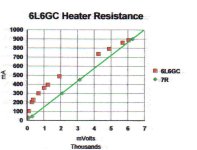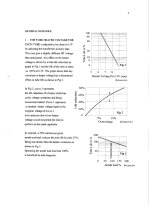And here it is compared to a 7R resister, done on a much earlier spreadsheet,There is also the issue of the positive temperature coefficient of the resistance of the heater.
not MS Excel. Think I was curious enough 20 yrs ago to run this. In general tube
heater resistance of several different types seemed to vary about 10X from cold to hot.
Attachments
Although the Radiotron Hd/Bk 4th ed does mention near the beginning a description on voltage variations on tube life, it doesn´t provide any graphs. The graphic model I dug out nearly 30 yrs ago highlights the varying heater voltage on tube life, but the variation of anode load is not nearly so damaging .My approach with AC transformers is to have multiple incremental taps on the primary to deal with this.
However, the real problem in the early TV days was the series heaters using a ballast baretter with no input transformer was the worst of all conditions. No isolated chassis to the user, it was also mighty dangerous.
With low impedance european mains networks the C speed utility switchboard relays would immediately flip out with the slow (T) fuse approach. In my power amps of 500W upwards, on the primary side I always use a relay switching out a ballast resistor after 5-7 secs. This enables a fuse rating far more appropriate to the actual power.
However, the real problem in the early TV days was the series heaters using a ballast baretter with no input transformer was the worst of all conditions. No isolated chassis to the user, it was also mighty dangerous.
With low impedance european mains networks the C speed utility switchboard relays would immediately flip out with the slow (T) fuse approach. In my power amps of 500W upwards, on the primary side I always use a relay switching out a ballast resistor after 5-7 secs. This enables a fuse rating far more appropriate to the actual power.
Attachments
very good advice - thank you very much. This is from page 111 of this magazine:
https://worldradiohistory.com/Archive-Radio-News/50s/Radio-News-1957-07-R.pdf
go also to
https://www.diyaudio.com/community/threads/heater-voltage-range-hi-or-low.31770/page-2#post-7458953
and
https://www.diyaudio.com/community/threads/service-life-at-low-plate-current.194910/
A lot of additional details are mentioned here (until now the best I found):
https://audioxpress.com/article/the-internal-life-of-vacuum-tubes#:~:text=Glass out-gassing rises exponentially,leakage (see Figure 2).
more URLs:
https://audioxpress.com/article/how...tubes-use-a-tube-amplifier-high-voltage-delay
https://audioxpress.com/article/you-can-diy-a-high-voltage-delay-for-tube-amplifiers-the-sequel
https://audioxpress.com/article/book-review-getting-the-most-out-of-vacuum-tubes
https://allforturntables.com/2023/08/02/how-long-do-power-tubes-last-2/?utm_content=cmp-true
https://worldradiohistory.com/Archive-Radio-News/50s/Radio-News-1957-07-R.pdf
go also to
https://www.diyaudio.com/community/threads/heater-voltage-range-hi-or-low.31770/page-2#post-7458953
and
https://www.diyaudio.com/community/threads/service-life-at-low-plate-current.194910/
A lot of additional details are mentioned here (until now the best I found):
https://audioxpress.com/article/the-internal-life-of-vacuum-tubes#:~:text=Glass out-gassing rises exponentially,leakage (see Figure 2).
more URLs:
https://audioxpress.com/article/how...tubes-use-a-tube-amplifier-high-voltage-delay
https://audioxpress.com/article/you-can-diy-a-high-voltage-delay-for-tube-amplifiers-the-sequel
https://audioxpress.com/article/book-review-getting-the-most-out-of-vacuum-tubes
https://allforturntables.com/2023/08/02/how-long-do-power-tubes-last-2/?utm_content=cmp-true
Last edited:
anode voltage time delay in tube amplifiers after switch on:
https://sound-au.com/valves/ht-delay.html
https://audioxpress.com/files/attachment/2696
https://audioxpress.com/files/attachment/2694
https://audioxpress.com/article/how...tubes-use-a-tube-amplifier-high-voltage-delay
https://www.diyaudio.com/community/threads/tube-amp-high-voltage-delay.343711/
https://sound-au.com/valves/ht-delay.html
https://audioxpress.com/files/attachment/2696
https://audioxpress.com/files/attachment/2694
https://audioxpress.com/article/how...tubes-use-a-tube-amplifier-high-voltage-delay
https://www.diyaudio.com/community/threads/tube-amp-high-voltage-delay.343711/
I have a related question if it's okay to ask here. It would be nice to add a circuit which counts the power on time (usage) in hours and perhaps also the number of power on/off cycles. Does this type circuit have a name. Perhaps there are some commercial pcb/ kits available which can be added, but I couldn't find anything on the web, but I may be searching for the wrong name. If someone could point me in the right direction that would be appreciated.
gupsta, such information may help you appreciate when to either swap your output tubes, or otherwise do some performance checking (ie. that everything is operating as expected), but otherwise would have no tangible benefit I would suggest.
Certainly run hour meters are quite common.
Meaningful statistics from such a use meter would need many many many people doing the same, and then some power statistical and analytic investigation to see if any reliable view could then be formed, given the wide range of gear being monitored. If you used say an amp that at least tens of others also used, and were ok to monitor, and you gave everyone a new set of valves of the same maker/model/year then that may make any assessment easier, but would take quite some time.
Certainly run hour meters are quite common.
Meaningful statistics from such a use meter would need many many many people doing the same, and then some power statistical and analytic investigation to see if any reliable view could then be formed, given the wide range of gear being monitored. If you used say an amp that at least tens of others also used, and were ok to monitor, and you gave everyone a new set of valves of the same maker/model/year then that may make any assessment easier, but would take quite some time.
gupsta,
If you have an amplifier that is killing tubes quickly, or earlier than you think they should . . .
Tell us how approximately how many hours the tubes have been run.
Then you should:
Consider finding or making a complete and accurate schematic, and making measurements of voltages and currents; marking those on the schematic, then posting them here.
Perhaps someone will be able to see if one or more tube's maximum specifications are being violated.
Also:
If the output tubes are self biased, or have a current sense resistor in the cathode, you might want to check them, then check again in 3 months, and if there is little or no change, then chack again in a year.
Check how hot the tubes run, whether they are stuck in a corner without much air flow, etc.
Think about what you do to keep your car running smoothly, and not stop working.
Just a few things to think about.
If you have an amplifier that is killing tubes quickly, or earlier than you think they should . . .
Tell us how approximately how many hours the tubes have been run.
Then you should:
Consider finding or making a complete and accurate schematic, and making measurements of voltages and currents; marking those on the schematic, then posting them here.
Perhaps someone will be able to see if one or more tube's maximum specifications are being violated.
Also:
If the output tubes are self biased, or have a current sense resistor in the cathode, you might want to check them, then check again in 3 months, and if there is little or no change, then chack again in a year.
Check how hot the tubes run, whether they are stuck in a corner without much air flow, etc.
Think about what you do to keep your car running smoothly, and not stop working.
Just a few things to think about.
As hour meter there is some models avalable https://www.ebay.com/itm/3644373489...M/S6zE8VtAvmf39i9znnhEGg==|tkp:Bk9SR4Tj0IzYYgI have a related question if it's okay to ask here. It would be nice to add a circuit which counts the power on time (usage) in hours and perhaps also the number of power on/off cycles. Does this type circuit have a name. Perhaps there are some commercial pcb/ kits available which can be added, but I couldn't find anything on the web, but I may be searching for the wrong name. If someone could point me in the right direction that would be appreciated.
In my vulture amps 500W+, 15 yrs ago I then used the square Veeder-Root 799988-412. To my surprise if one goes to component suppliers these small pieces of kit are now horribly expensive.
Best so far is https://www.ebay.com/itm/224186771136
The key nomenclature using search engines is type "Totalizing Counters".
rJ
Best so far is https://www.ebay.com/itm/224186771136
The key nomenclature using search engines is type "Totalizing Counters".
rJ
That was standard practice in the past due to the huge volume manufactured, likely more automated than today's production lines I suspect. This video shows a lot of automated and semi-automated steps of manufacture at the height of volume productionUsing robotic manufacturing methods, companies should be able to produce the most consistent, highest quality tubes ever.
- Home
- Amplifiers
- Tubes / Valves
- Extending Life Expectancy of Power Amp Tubes like EL34 by which kind of Switch-On Variants - which one is most useful ?



